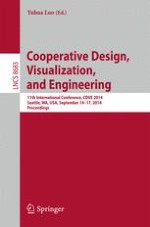This book constitutes the refereed proceedings of the 11th International Conference on Cooperative Design, Visualization, and Engineering, CDVE 2014, held in Seattle, WA, USA, in September 2014. The 33 full and 10 short papers presented were carefully reviewed and selected from 78 submissions. The papers cover topics such as cloud technology; the use of cloud for manufacturing, re-source selection, service evaluation, and control; methods for processing and visualizing big data created by the social media, such as Twitter and Facebook; real-time data about human interaction; sentiment analysis; trend analysis; location-based crowdsourcing; effective teamwork; cooperative visualization.
